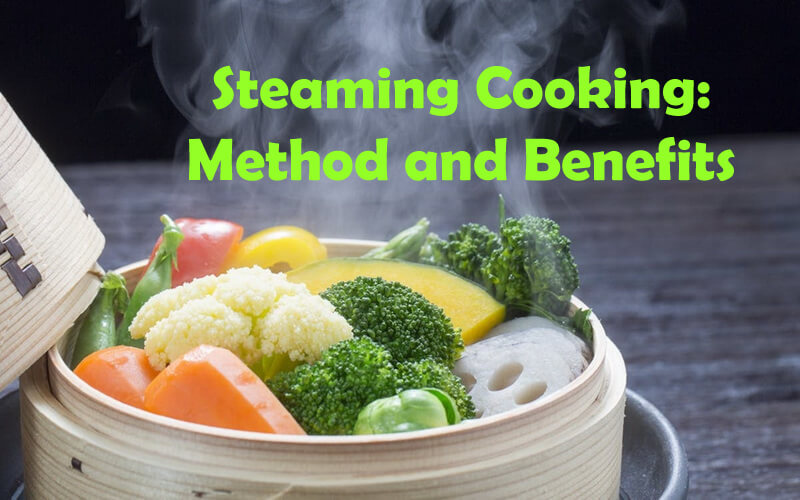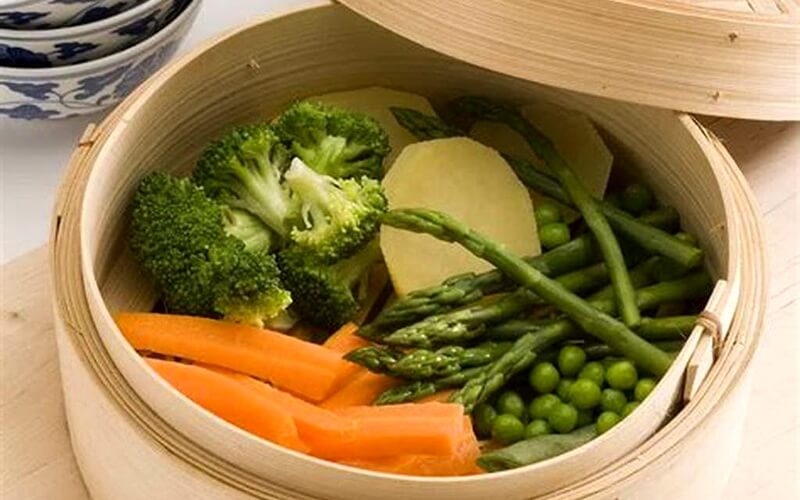Steaming Cooking: Method and Benefits
Steaming is considered a healthy cooking method that can be used for many kinds of foods. Here are some benefits of steamed foods and how to steam vegetables.

8 Benefits of Steaming Cooking Method
1. Low in Calories
Steamed foods are typically lower in calories than those made using methods such as frying or sautéing. This can help with weight management and overall wellness.
Individuals preferring to avoid additional fat intake may prefer steaming to methods which require cooking oil.
2. Preservation of Flavor
Steaming helps to maintain the natural flavors of the ingredients. It doesn't add excessive fats, oils, or seasonings, allowing the true taste of the food to shine through.
By steam-cooking, the vegetables are kept as close to their natural raw state as possible, whilst still heating through thoroughly. This not only prevents the vegetables from turning into a mash or purée, but it also allows them to retain their original colour, taste, juices and freshness. If you want to add some aromatic flavour to the food, you can add herbs and spices to the water.
Especially when the vegetables themselves have so much flavor, simply steaming them and finishing with fresh herbs, lemon juice, and extra virgin olive oil can produce a very satisfying and delicious dish.
When you steam food, you may simply prevent overcooking or scorching it.
3. Retention of Nutrients
Steaming is one of the best cooking methods for maximizing taste and color, while retaining the most nutrients in vegetables and fish.
Steaming is one of the best ways to preserve the nutritional value of food. It minimizes the loss of vitamins, minerals, and other essential nutrients because the food doesn't come into direct contact with water. This makes steamed dishes a healthier option.
According to a USDA analysis of steaming and boiling vegetables in 2007, folic acid and vitamin C are the most affected nutrients. Steaming reduces folic acid by 15% when compared to raw ingestion, and boiling reduces it by 35%. Vitamin C is reduced by 15% when steamed, and 25% when boiled.
4. Simple and Quick
Steaming is often a faster cooking method than baking or roasting. Steamed dishes require minimal cooking time and consume meager fuel resources, rendering them a judicious choice for those seeking to save time and effort.
You can also healthy steam several vegetables or vegetables and fish in one pot for easier clean up.
5. Healthier
Steamed dishes typically contain minimal amounts of oil and salt. In comparison to stir-fried dishes, the fat and sodium intake is much lower, which can contribute to better heart health and reduced risk of certain health conditions.
6. Lower Cholesterol
Steaming removes the fat from meats such as lamb or hog, allowing it to be readily removed, whereas traditional cooking methods such as grilling, baking, or frying sear the fat into the flesh. By removing the fat, the meat becomes reduced in calories and cholesterol. Additionally, steaming eliminates the necessity for cooking oil or fat, resulting in lighter and healthier meals.
Find out more here: 8 basic cooking methods
7. Increase or Decrease Nutrients
When compared to boiling, steaming produced 42% more glucosinolates in broccoli cooked to medium firmness. Steaming has been shown to maintain phenolic chemicals with antioxidant characteristics substantially better than boiling or microwaving. When compared to boiling, steaming preserved the β-carotene in carrots.
8. Easy Preparation
Steamed meals are surprisingly simple to prepare. It requires only the act of boiling or steaming the ingredients, with little need for a plethora of condiments.
It involves minimal preparation, and you don't need to use much oil or other ingredients. This makes it an accessible cooking method for both beginners and experienced cooks.
In conclusion, the choice of steaming as a cooking method is based on its ability to produce nutritious, tasty, and low-calorie dishes, as well as its ease of preparation and potential health benefits.

How to Steam Vegetables
Fill the bottom of the steamer with 2 inches of water. Make sure the water is at a rapid boil before adding your vegetables to the steamer basket. This ensures that the heat is consistent throughout the cooking time. Steaming cooking the vegetables with the even, moist heat of the vapors.
Place food and vegetables in a steamer basket. You want to make sure the steamer has a tight-fitting lid. You can steam more than one vegetable (both requiring the same amount of cooking time) by placing the vegetables in the steamer basket in layers.
Or, if you want to cook vegetables at different cooking times, begin cooking the vegetables that require more cooking time and add the other vegetables afterwards. For example, cook sweet potatoes (which require 7 minutes of steaming) for 2 minutes before adding broccoli (which requires 5 minutes of steaming).
Steaming Vegetables and Fish Together
You can easily steam a variety of vegetables with a nice piece of salmon or other fish on top. This is a perfect way to make a simple, clean, healthy meal in one pot in a very short amount of time.
You can make a simple dressing or sauce and drizzle it over everything when done. Try steamed salmon and asparagus with mustard dill sauce, this is a delicious example of steaming your whole meal in layers in the same pot.
Note: Remember that steam can be deceiving. It is still very hot and can burn you easily, so it is important to remember to open the lid on your steamer facing away from your body. This will prevent the steam from burning your face or arms as you lift the lid.